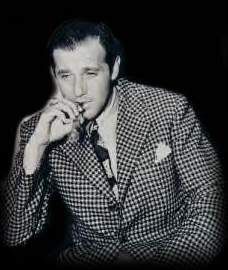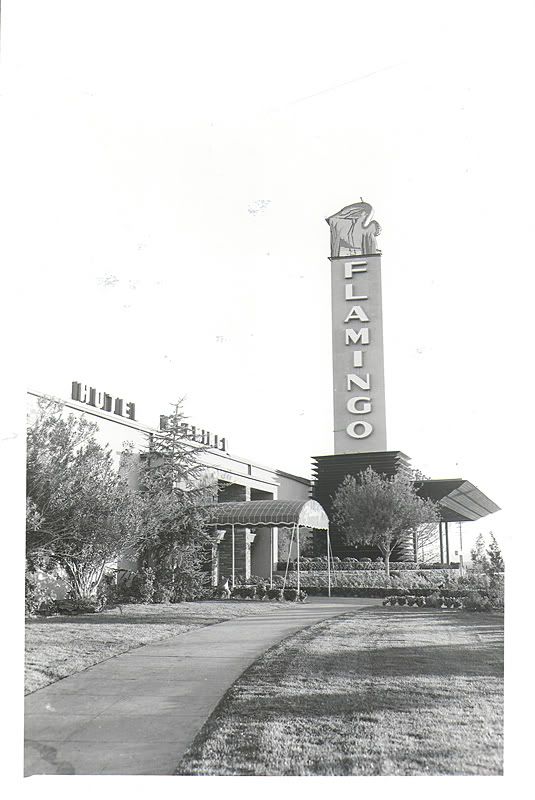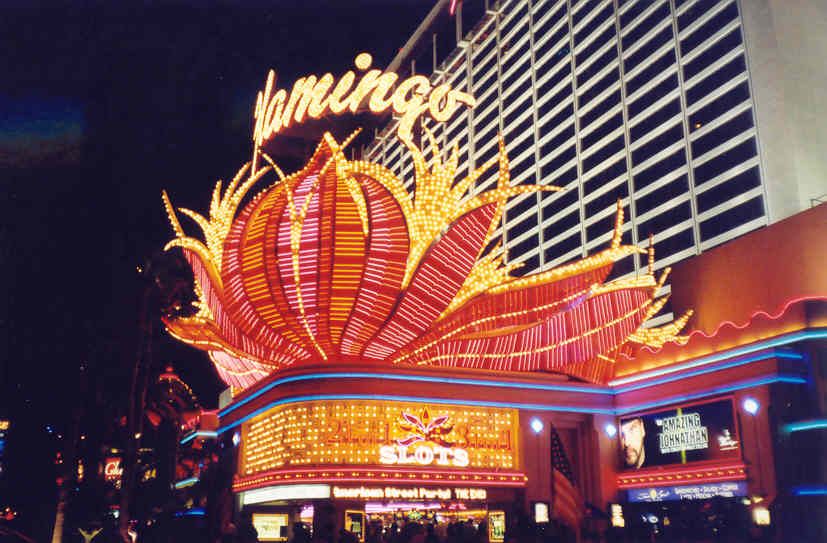Check out my Las Vegas Travel Adventure!
The Hilton Grand Vacations at the Flamingo property includes a 72,299-square-foot (6,716.8 m2) casino along with 3,626 hotel rooms. The 15-acre (6.1 ha) site's architectural theme is reminiscent of the Art Deco and Streamline Moderne style of Miami and South Beach. Staying true to its theme, the hotel includes a garden courtyard which serves as a wildlife habitat for flamingos. The hotel was the third resort to open on the Strip and remains the oldest resort on the Strip in operation today. The Flamingo has a Las Vegas Monorail station called the Flamingo/Caesars Palace station at the rear of the property. After opening in 1946, it has undergone a number of ownership changes.
Bugsy Siegel

The name "Bugsy" is a term of endearment or honor in the gangster world and is given out to those that show no fear in sticky situations, or who are willing to do the jobs that others are afraid to take. Bugsy Siegel hated the name and anyone who used it to his face risked their own personal health, as Siegel was not a man to mess with. Siegel preferred to be called Ben and if you didn't know him, "Mr Siegel" would be your best way of addressing him.
Siegel was probably the most colorful, and the most charming, of the famous syndicate killers. In the 1930's Siegel was sent from Brooklyn to California to run the syndicate's West Coast operations, including the lucrative racing wire service for bookmakers. It was here that he found his niche. He was suave and entertaining and became friends with Hollywood celebrities like Jean Harlow, George Raft, Clark Gable, Gary Cooper and Cary Grant. Many of them even put money into his enterprises. On one hand, he was the life of the party and on the other, a cold-blooded killer. On occasion, Siegel could be at a party with his "high class friends" and then slip away for a gangland execution, all in the same night.
Benjamin “Bugsy” Siegel went down in crime history as the man who made Las Vegas into the gambling Mecca of the United States. Siegel didn't invent Las Vegas. He wasn't even the first person to look at the desert area and its two track railroad junction. He merely saw a standard mob related opportunity and decided to act on it.
Initially Siegel didn't see any worth in Vegas at all. It was hot, arid and in the middle of nowhere. However Vegas did have one major thing going for it and that was it was in the state of Nevada; and in Nevada it was legal to gamble. His friends and associates on the East Coast already ran a couple of floating casinos that operated outside the three mile US territorial limit. However, setting up a permanent lavish casino in Las Vegas would give them a chance to set up a business that was both legitimate and a license to print money.
Siegel tried to buy up some established gambling joints in Vegas but this proved unsuccessful until he met Billy Wilkerson. Wilkerson was trying to build the the most luxurious hotel that Vegas had ever seen. It would have individual air conditioning, tiled bathrooms and swimming pools. However, Wilkerson had a cash flow problem. This is where Bugsy Siegel came in. He took a controlling interest in the venture. Siegel had it in his mind to create an oasis in the desert where travelers from both the East and West Coast could come for gambling, fine food, luxury accommodations and fabulous entertainment.
Bugsy convinced his fellow gangsters to invest a million dollars to build the Flamingo, rumored to be the nickname of his mistress, Virginia Hill. Some of the gangsters used their own money in the project as well as the mob's; and it was this factor that would ultimately lead to Bugsys death.
The cost of the project soon spiraled out of control as Bugsy was being ripped off behind his back. The original $1.2 million price tag quickly went up to $6 million, and the investors became increasingly worried. By December 1946, a year after the start of the project, the casino had not produced any revenue at all and was sucking the mob dry. As the mobsters were deep in debt, Siegel went back to his Hollywood friends to get more cash.
The mob was not pleased with Siegel and wanted something done about him. They felt that something should be done, but were persuaded by Meyer Lansky to give Bugsy a chance by waiting until The Flamingo opened at Christmas. If it didn't make money when it opened then the mobsters could issue a contract on Siegel's life.
Christmas came and went and The Flamingo opened—although not entirely finished. Siegel pulled out all the stops in hiring the best live entertainment; but the casino was a flop. Although everything was a great lavish spectacle just as intended, no locals came as Vegas was a cowboy town. The weather around opening time was atrocious which didn't help and with no hotel rooms the guests gambled in the casino and took their winnings back to the Frontier or to some of the downtown casinos. Most of the celebrities left after a few days, leaving the place virtually empty.

The mob was furious and calling for Siegel's blood; but Bugsy was again saved by Meyer Lansky who was convinced that Las Vegas could become profitable. It was agreed that the original Flamingo Corporation should be put into receivership to stop the losses and then the mob could buy out the original partners. Bugsy had a reprieve.
The Flamingo limped through the month of January until Siegel ordered it closed until the hotel could be finished. No rooms meant the customers were leaving with their winnings. The Flamingo reopened in March with the hotel mostly finished and it appeared that Bugsy had got away with it when the resort reported a profit of over $250,000 for the first half of 1947 despite the disastrous start.
On the evening of June 20, 1947 Ben Siegel was in the Beverly Hills home of Virginia Hill when he was shot in the head. Four more bullets hit his body, and at 42 years of age Bugsy Siegel was dead.
It appeared that the mob never really forgave him for the financial problems that he put them through. With many investing their own money, it appears that revenge was the motive for the killing. No one really knows who killed him, but there were none of his so called friends at his funeral.
The Las Vegas that Bugsy knew doesn't exist anymore. The big hotel chains and developers eventually moved in to build the new hotels and casinos that dwarfed the image of The Flamingo. For many years The Flamingo did represent the best of Las Vegas; and with more than 3,500 rooms, it was one of the largest hotels in the world.
The Flamingo was acquired by the Hilton Corporation in 1972 and became the Flamingo Hilton in 1974. The last of the original Flamingo Hotel structure was torn down on December 14, 1993; and the hotel's garden was built on the site, complete with a plaque to Bugsy Siegel.

Ever since his untimely demise there have been sightings of Bugsy's smiling phantom, nattily attired in a smoking jacket and slacks in the style of times long since past. He usually appears in and around the rose garden — with its swans, waterfalls, birds, roses and brightly colored koi fish — or in the wedding chapel area. Bugsy is also believed to haunt the Presidential Suite of the Flamingo, where he lived for several years before his death. Guests in this room have reported a number of strange encounters with his ghost, from eerie, moving cold spots to items that vanish and move about the suite. They have also seen his apparition in the bathroom and near the pool table. Those who have encountered him say this spirit does not seem unhappy or distressed and in fact, seems content to still be around.
The hotel may not be the only place he haunts. Virginia Hill’s former home, which is a private residence on Linden Drive in Beverly Hills, is reportedly still haunted by the panicked presence of Bugsy Siegel as he scrambles for cover, attempting to hide from the bullets that killed him. His stark fear, as he spotted his killer and knew that the game was up, has left an indelible impression on the house. According to reports, witnesses have been surprised for years by the apparition of a man running and ducking across the living room of the house, only to disappear as suddenly as he came.
A psychic who was brought in to investigate the house claimed that the image was the residual presence of Bugsy Siegel, imprinted on the place in his last desperate moments before death.
Sources:
http://www.prairieghosts.com/hollywood11.html
/////


No comments:
Post a Comment